Your mechanic may often recommend that an alignment service be performed on your vehicle and it’s a good idea to do so about every six months – or immediately if you’ve hit something that could have caused damage.
What exactly is the alignment? It is an important suspension-tuning tool that influences the operation of your vehicle's tires. The alignment of your car describes a complex system of suspension angles that are being measured and a variety of suspension components that are being adjusted.
Proper alignment is key to tire wear, comfort, and fuel efficiency.
How does your suspension alignment change?
Normal wear. Pot holes. Curbs. Minor accidents.
As your suspension parts wear, or any time your suspension takes a hit, whether by hitting a pot hole, a curb, or anything in a minor accident, it can cause the alignment to get knocked out of place. It’s important that wheels and tires are aligned. If they aren’t, you could be damaging your tires and affecting the vehicle’s handling characteristics.
Tire Performance
If the suspension is out of alignment, there is uneven pressure on the tires that can cause your car to work harder on the tires than it needs to. This happens because there is more resistance between the tire and the road surface.
That resistance can cause the tires to wear unevenly with the tires ultimately becoming worn on one side. It’s dangerous to drive on uneven tires, and it could force you to purchase tires sooner than you would have needed to with a proper alignment.
Comfort
When tires begin to wear unevenly, you may feel a vibration in the steering wheel. The tires may also produce more road noise when the tread is uneven.
Fuel Efficiency
Your car works harder when the tires wear unevenly. The harder the car works, the more fuel it burns. So when the tires are out of alignment and the tires begin to wear unevenly, the more money you end up paying in gas.
Alignment Verification System
Continental’s Alignment Verification System (AVS) technology gives you driving confidence and helps you save money down the road.
Vibrations in the steering wheel or free rolling steering wheels are clear indicators that the vehicle’s wheel alignment must be checked. However, small wheel misalignments often remain unnoticed which can result in unnecessary costs due to wear and tear of the tires, and increased fuel consumption.
Fortunately, innovative Alignment Verification System (AVS) technology from Continental - which provides an early warning system to drivers when it’s time to align their vehicle - helps to achieve the lowest overall driving costs.
Make sure to keep an eye on your alignment for a confident and comfortable ride. Not to mention, you’ll save money down the road!
Click here for more tips on tire maintenance!
Alignment assures your tires meet the road at the proper angle, your wheels are pointing straight and your tires are centered in the wheel wells. It adjusts the angles of your vehicle’s wheels to original specs for best gas mileage, proper road contact, a smooth ride, and the longest tire life.
It adjusts the angles of your vehicle’s wheels to original specs for best gas mileage, proper road contact, a smooth ride, and the longest tire life.
An alignment service is important to do when:
We recommend an alignment after the installation of new tires. This helps you get the most life from your new tires. Wheel alignment checks are always advised after a significant impact or uneven tire wear is detected.
Also, get a check annually, or twice yearly if you typically travel on rough roads. Regular checks are important because alignment issues aren’t always obvious.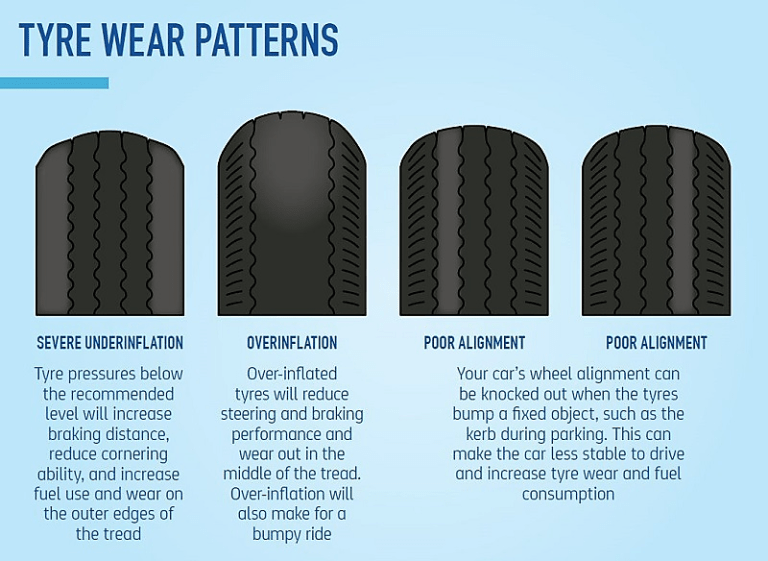 The wrong toe angle can go unnoticed and so can atypical tire wear. Cars usually go out of alignment gradually, so you may not realize how much it was impacting drivability, gas mileage or tire wear until it’s corrected.
The wrong toe angle can go unnoticed and so can atypical tire wear. Cars usually go out of alignment gradually, so you may not realize how much it was impacting drivability, gas mileage or tire wear until it’s corrected.
The most common signs of misalignment are pulling to one side while you’re driving, unusual tire wear and/or a steering wheel that’s off-center even though your vehicle is pointed straight. But these symptoms can have other causes, sometimes simpler and sometimes not.
Steering pull can be caused by road conditions. If the asphalt has grooves that are slightly farther apart than your car’s axles, you may feel a pull as the tires on one side ride slightly higher. If the road is noticeably higher in the center, the vehicle may veer as the tires try to find a level surface.
Torque steer is a pull that happens during acceleration, from a difference in power being delivered to the wheels. A pull only during braking is probably from a caliper on one side sticking and not fully disengaging from the brake disc.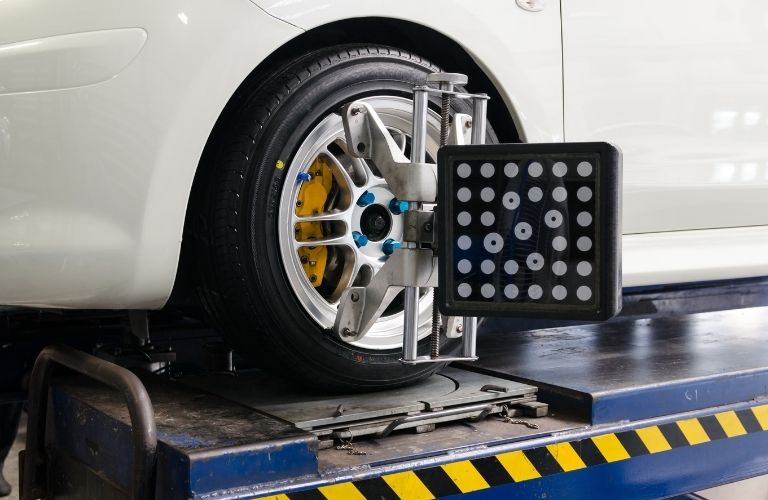 A failing tire and improper tire rotation are two more causes of steering wheel pull.
A failing tire and improper tire rotation are two more causes of steering wheel pull.
Poor alignment may not be the issue if your steering wheel sometimes tugs in one direction and then the other. A bent or worn suspension part — ball joints, strut bearings or tie rods — could be to blame.
Atypical tire wear may be the result of worn shocks or struts, bushings or springs, or from carrying heavy loads (all of which can also put your vehicle out of alignment). Uneven wear can also be caused by driving on over-, underinflated or imbalanced tires.
An off-center steering wheel can be caused by worn steering or suspension parts. Just getting an alignment won’t fix the root cause.
One last common point of confusion: Vibration while underway is often a symptom of out-of-balance tires, not bad alignment.
Lifting or lowering a vehicle will affect your toe, camber or caster angles. So will repair or replacement of suspension and steering parts — struts, shocks, ball joints, tie rods, bushings or control arms. If one of these components is damaged, it’s a pretty good bet your vehicle’s alignment is out of spec. If you don’t fix them before your vehicle is aligned, you’ll soon have the problem recur.
If one of these components is damaged, it’s a pretty good bet your vehicle’s alignment is out of spec. If you don’t fix them before your vehicle is aligned, you’ll soon have the problem recur.
Because the measurements are very fine, misalignment is not something you can see by just eyeballing whether the wheels and tire angles look right. But an experienced tire technician will usually know if you’re overdue for an alignment just by looking at your tire wear.
Here’s what to know if the service is recommended:
 You can verify the job was truly necessary. Here’s an example of what you’ll see.
You can verify the job was truly necessary. Here’s an example of what you’ll see.While looking at existing tire wear is one way to identify misalignment, It’s ideal to have your vehicle aligned annually to help catch and correct any misalignment issues before you experience early and unnecessary tire wear. Regular alignments are part of basic maintenance that help you get full mileage out of your tires.
Monday, July 18, 2016 12:27:01 Europe/Moscow
Ever since the use of carriages and horse-drawn vehicles, the wheels on them were installed with slight deviations from the longitudinal and transverse axes car. This was done for different purposes, for example, the wheels were placed with the right side out, so that when driving, the dirt would not fall on the passengers, or vice versa, so that the wheel would not come off the axle when the dowel was lost (the pin holding the wheel).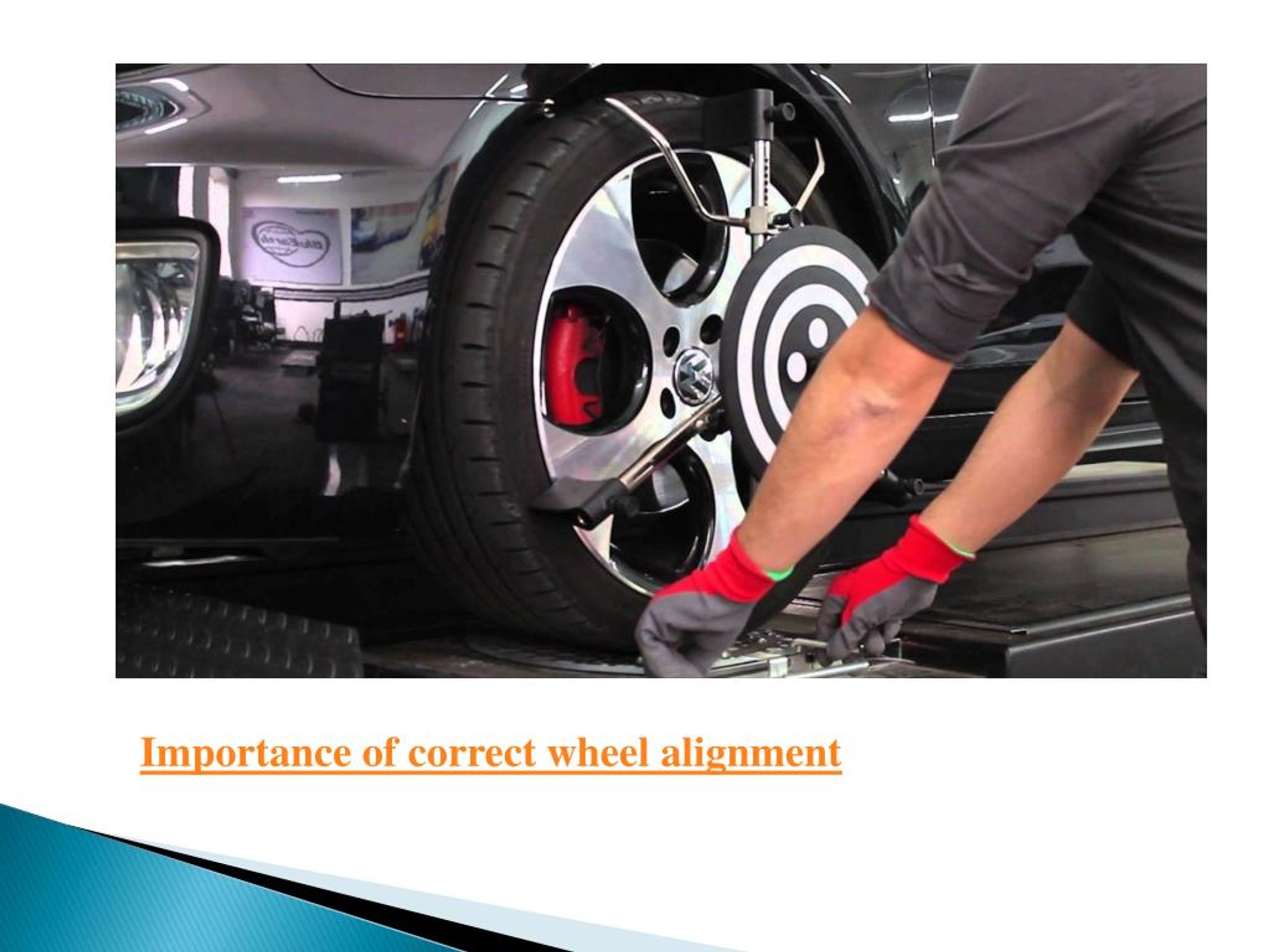 Carriages have long gone, but the installation of wheels with different inclinations has reached and is used in modern cars. These settings are called wheel alignment. Next, we will look at the main ones.
Carriages have long gone, but the installation of wheels with different inclinations has reached and is used in modern cars. These settings are called wheel alignment. Next, we will look at the main ones.
In service centers, we often see a suggestion to adjust the wheel alignment. In the phrase "dismantling-collapse" two parameters of wheel installation are hidden at once. The first one is convergence/divergence . Toe-in is the angle between the plane of rotation of the wheel and the longitudinal axis of the vehicle as viewed from above. If the planes of the wheels intersect in front of the car (as in the picture on the right), then this is called a convergence, if behind the car, then a divergence.
The vast majority of production vehicles have front wheel toe-in. Firstly, it allows you to compensate for the effect of longitudinal forces on the wheel during rolling. Secondly, it improves handling and stability on the road. There are also reverse examples: with a small discrepancy between the wheels, the speed of reaction to turning the steering wheel increases. Such settings are often used in motorsport. But in everyday life, other benefits of toe-in are much more important than excessively “sharp” steering when diverging.
There are also reverse examples: with a small discrepancy between the wheels, the speed of reaction to turning the steering wheel increases. Such settings are often used in motorsport. But in everyday life, other benefits of toe-in are much more important than excessively “sharp” steering when diverging.
Another important wheel setting is camber. Camber is the angle between the vertical and the plane of rotation of the wheel, when viewed from the front of the car. Camber can be positive (if the top of the wheel is facing out) or negative (if the wheel is facing towards the body). With the development of various types of suspensions on cars, both positive and negative camber angles are encountered. The positive angle is designed to compensate for the displacement of the wheels when the axle is loaded (static load, or dynamic during acceleration and braking). Negative camber improves traction and stability. Negative camber machines can be seen in car racing, but these settings are detrimental to tire life.
As a rule, wheel alignment values are indicated by the ranges within which they can be set. Even small changes in these angles affect the handling and stability of the car, because the wheel must maintain an optimal position in all driving modes, at all speeds and on various surfaces. And by adjusting the kinematics of the suspension and setting these angles, one or another automaker can give a different character to their models.
Wheel alignment also affects tire wear. With incorrect settings, the tire may wear out unevenly, which will cause it to fail earlier. In some cases, by wear, you can determine which settings have gone astray in the suspension.
Incorrect camber will result in increased wear on one side of the tire. In the case of excessively positive camber, the outer part of the tire tread will wear out more intensively. With negative camber, on the contrary, the inner part of the tire will wear out more. In case Incorrect toe angle settings The tire begins to wear unevenly and burrs appear on it that you can feel with your hands. If you feel these burrs when moving with your hand, from the outside of the tire to the inside, then you have insufficient toe-in. And if, on the contrary, when moving the hand from the inside outward, then the toe-in of the wheels is excessive.
In case Incorrect toe angle settings The tire begins to wear unevenly and burrs appear on it that you can feel with your hands. If you feel these burrs when moving with your hand, from the outside of the tire to the inside, then you have insufficient toe-in. And if, on the contrary, when moving the hand from the inside outward, then the toe-in of the wheels is excessive.
But this is in theory, but in reality, according to our research, about 5% of summer tires have wear increasing from one shoulder to another and about 20% have a worn shoulder. All this happens because of wrong wheel alignment . Therefore, regularly inspect and check your tires for damage and uneven wear and keep an eye on the technical condition of your vehicle.
After what do the collapse - convergence? Do I need to do balancing after the collapse? What courses are useful for learning tire fitting?
Wheel alignment (also common are such service operation names as wheel alignment and wheel alignment, or abbreviated as RUUK) is a procedure aimed at adjusting the wheels relative to the body.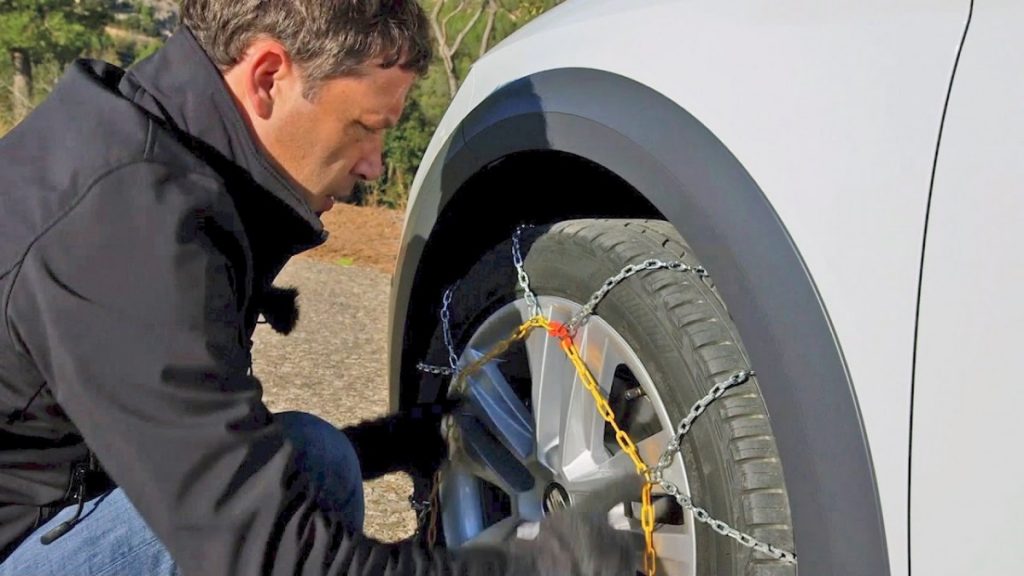 If the alignment is not performed or done illiterately, this is fraught with a number of problems for the vehicle and its owner:
If the alignment is not performed or done illiterately, this is fraught with a number of problems for the vehicle and its owner:
The result of wheel alignment is to ensure that the vehicle has the correct position of the wheels at different angles of rotation and at different speeds.
The direct impact is on the level of traffic safety. If everything is in order with the wheel alignment with heavy traffic, the driver at the most unexpected moment will ensure a prompt change in the trajectory of movement.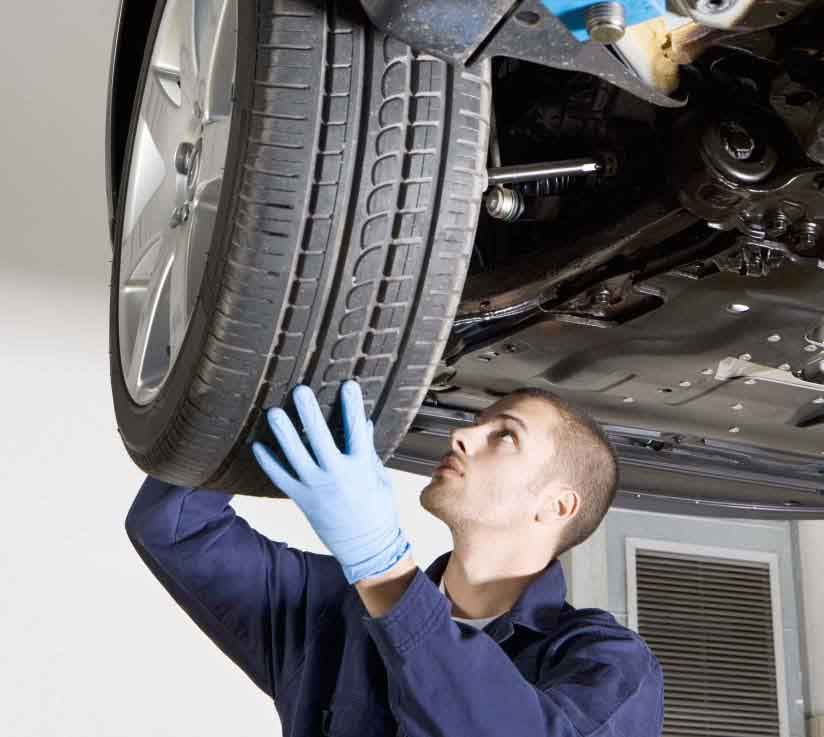 When turning, there will be no sliding, and after passing the turn, the vehicle will easily return to its original position.
When turning, there will be no sliding, and after passing the turn, the vehicle will easily return to its original position.
Wheel alignment refers to adjustable parameters.
The main geometric indicators are:
Toe angle is the angle between the median plane of the wheel and that plane which is parallel to the longitudinal plane of symmetry of the vehicle, provided the wheels are aligned for straight motion.
Average values of convergence angles:
The sum of the angles for the left and right wheels forms a full convergence.
If the toe of the left and right wheels are equal, it is a half toe.
Toe tolerance for each wheel at car services is ±5'.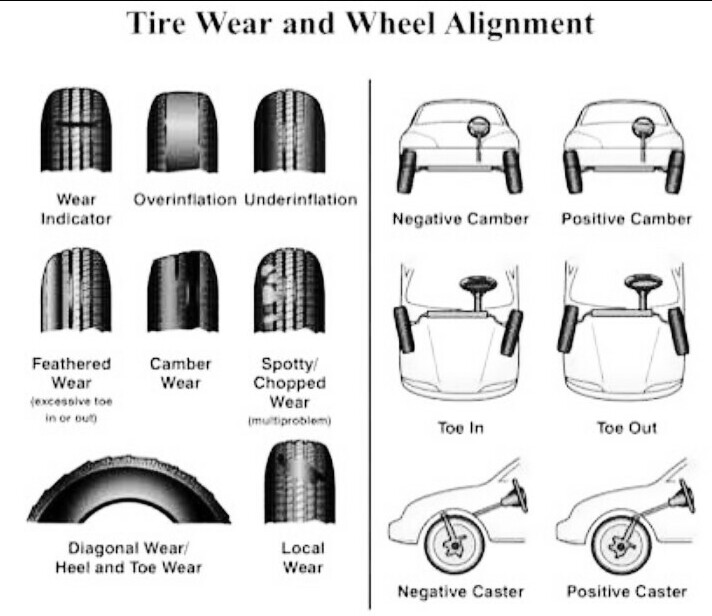
Camber angle (or simply camber) is the angle formed between the vertical and the plane of rotation of the wheel.
Average camber angles:
Structurally, the vehicles are different and the initial camber angles are different. There are zero, negative and positive angles.
 It's basically racing cars. A negative angle value gets the maximum wheel contact with the road. For riders, this is priority #1. True, tire wear is colossal. Because of this, it is not an option for "ordinary" cars. Impractical. But in competitions, when speed is important, it is easy to get the desired effect. For drifting, you can’t think of a better one.
It's basically racing cars. A negative angle value gets the maximum wheel contact with the road. For riders, this is priority #1. True, tire wear is colossal. Because of this, it is not an option for "ordinary" cars. Impractical. But in competitions, when speed is important, it is easy to get the desired effect. For drifting, you can’t think of a better one. There are longitudinal angles of inclination of the axis of rotation. They are adjustable. Can change the value under the influence of the weight of the cargo in the trunk of the vehicle. The tolerance for left and right side cannot exceed 0°15'-0°40'.
The tolerance for left and right side cannot exceed 0°15'-0°40'.
There are also transverse angles of inclination of the axis of rotation. They are unregulated.
Usually, when they talk about the angle of inclination of the axis at the tire fitting, they mean the longitudinal angle of the axis of rotation. It is located between the perpendicular plane to the surface of the roadway and the planes of symmetry of the wheel. The caster indicates the deviation of the wheel position relative to the shock absorber strut.
Axle alignment refers to the interval between the middle of the front axle and the middle of the rear axle.
Wheel alignment refers to the interval between the midpoints of the wheels of a particular axle.
The higher the value of the axle alignment parameter, the larger the interior space. The smaller the value of this parameter, the higher the maneuverability.
As such, service operations relating to the collapse of the convergence and balancing are not interconnected.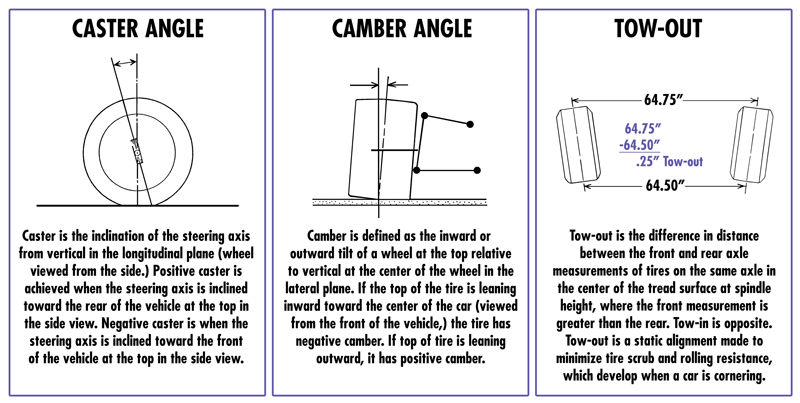 Therefore, there is no clear rule: if you have done RUUK, start balancing.
Therefore, there is no clear rule: if you have done RUUK, start balancing.
It is important to understand that the goals of these procedures are completely different:
But in practice, during maintenance, RUUK is often done in tandem with balancing. And there are two reasons for this:
Both prevention procedures are recommended to be performed every 7,00,000 - 8,000 km, for older cars when driving on bad roads, and every 15,000 - 20,000 km.
But, if we are not talking about scheduled diagnostics and maintenance, then the indications that are a loud bell for a particular service operation are different.
So the “indication” for RUUK is the change of tires, the installation of new disks, regular driving with slippage. Balancing is done if the tires are damaged on one side, the suspension is worried (blows are felt), the chassis was repaired.
True, if running gear is being repaired, you don’t need to “flog a fever” right away. The need for an RSMC depends on what exactly was changed and the diagnostic measures. If the steering rack was dismantled in order to adjust the pressure or replace the anther, then it is highly likely that the diagnostics will show: the parameters are not knocked down.
If the steering tips were replaced, the circumstances are somewhat different. RUUK is shown without fail. And diagnostic measures in this case are purposefully focused on solving such a question as to how much the geometric parameters deviated.
A number of motorists have a question: is RUUK needed when replacing silent blocks.
Let's figure it out: if the silent blocks of the racks (steering, rear), front axle are to be replaced, the camber parameters always deviate from the norm. And they need to be corrected.
Sometimes such a situation arises that the motorist performs the RUUK regularly, but hesitates to replace the silent blocks. It is unacceptable. RUUK in that case is “adaptive” not to the norm, but to the deformations that are inevitable due to aged silent blocks.
What is the result? Money thrown away. After all, the silent blocks will still have to be changed, and the wheel alignment must be done again.
RUUK is a very useful procedure for the “health” of the vehicle and ensuring the level of safety when replacing ball joints.
When replacing ball bearings, the old ones are disassembled, a backlash is formed and the geometric parameters naturally change. They need to be corrected.
But after replacing the shock absorbers, RUUK is an optional procedure, although car owners once again often perceive the replacement of shock absorbers as a direct incentive to go to wheel alignment.
The fact is that at least these auto parts do not have a direct effect on steering. They have no "power" over the tie rods.
They have no "power" over the tie rods.
If the work is performed in the traditional way, then it is recommended to adhere to the following algorithm:
It is always recommended to start work with the camber setting, and not with the convergence. Because when correcting convergence, you will not affect the collapse, and if you do the opposite, then in case of mistakes made at the initial stage, all settings will “fly”.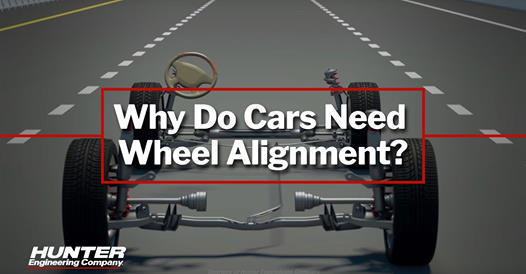
During work, be sure to check the pressure in the tires. Its complete stability is important.
If 3D stands are used, then it is important to understand that the mechanism is as follows:
SENSYS Engineering offers its trainees a basic e-training and knowledge test system "Tires, rims and tire fitting". These are 16 interactive modules and a system of tests that are “sharpened” for mastering such issues related to the construction of car wheels, disks and tires of vehicles, marking, and the pressure control system in them.